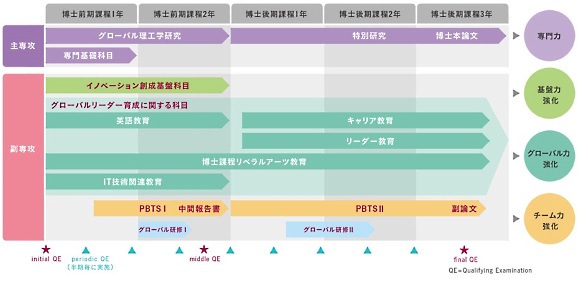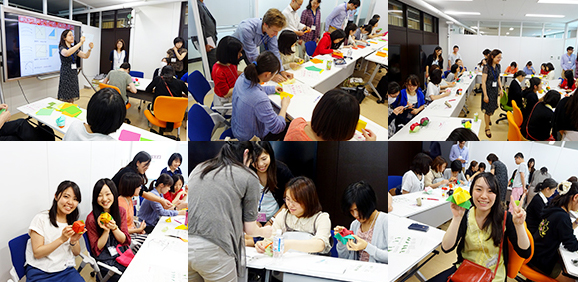1期生のPBTSチーム
Education Team
| Theme |
|---|
| Cultivation of student’s logical thinking through programming |
| Students |
| Akiko Mito (Chemistry & Biochemistry, the Division of Advanced Sciences, D1) Youyou Cong (Computer Science, the Division of Advanced Sciences,M2) |
| Description |
| The education team focuses on promoting the development of “logical thinking” among junior-high and high school students. “Logical thinking” is the ability to deconstruct a problem-solving task to make the best decision based on the situation (i.e. not rely on instinct or “standard practices” without thinking). The team’s effort is going toward designing a programming class since writing computer programs will allow students to apply their logical thinking skills. Akiko Mito is also looking into methods for designing a class and evaluating the abilities of students. Youyou Cong developed an extension of Ocaml programming language, called stepper. The stepper will assist students in writing (functional) programs. She is designing the materials for the programming class. |
| Schedule |
| The education team usually meets on Friday from 13:20 to 16:30, often finishes around 15:00. Otherwise, any change in the schedule will be noted to the leading center. |
Synchronization Team
| Theme |
|---|
| Analysis of patterns which cultured skin fibroblasts take |
| Students |
| Kimiko Yamashita (Physics, the Division of Advanced Sciences,D1) Kei Hashimoto (Biological Sciences, the Division of Life Sciences, D1) Kanako Enoyoshi (Mathematics, the Division of Advanced Sciences, M2) |
| Description |
| This is a strongly multi-disciplinary subject where experiments in Biology, data analysis, Physics, programming, modelling come into play. Skin fibroblast is the major cell responsible for skin (connective tissue) production, whose collagen is an important component. It is believed that collagen promotes motility of fibroblasts. In order to measure this, experiments were realized with three different concentrations of collagen. From the pictures taken during the experiments, the dominant “orientation” of blocks of fibroblasts were estimated using a software, and data analyses were performed through computing correlation of orientations among cells. Moreover, collagen also affects the geometry and homogeneity of fibroblast patterns; these were quantified by “texture analysis”. A simple mathematical model based on the synchronization between the orientations of different cells was implemented. Now the same data analyses are currently performed on this model. |
| Schedule |
| Every Friday, from 13:20 pm |
Water purification Team
| Theme |
|---|
| Suggestion of a new biological treatment system for wastewater contaminated with used cooking oil |
| Students |
| Nanami Kawaguchi (Chemistry and Biochemistry, the Division of Advanced Sciences, M2) Kaori Nishida(Human-Environmental Sciences, the Division of Life Sciences, M2) Tomoka Nagase(Human-Environmental Sciences, the Division of Life Sciences, M2) |
| Description |
| Oil contamination in wastewater caused serious water pollution. However, organic material, oil, is one of the most difficult things to be decomposed in nature. Therefore, the government strictly regulates oil contamination levels of wastewater from industries, restaurants and even households. Currently there are several methods, such as biological, chemical and physical methods are available to remove oil. In this project, they would like to suggest new method which is the sustainable and environmental friendly procedure. The new method is based on biological method using the combination of enzymes and yeasts. To evaluate the applicability of the new methods, students will perform several experiments and researching the components of wastewater. |
| Schedule |
| Every Friday, from 13:20 pm |
Anti-aging Team
| Theme |
|---|
| Tea leaf processing: optimizing anti-aging properties of tea |
| Students |
| Ritsuko Tamura(Biological Sciences, the Division of Life Sciences,D1) Yuko Caballero(Food and Nutritional Sciences, the Division of Life Sciences,M3) Dongyang Li(Biological Sciences, the Division of Life Sciences,M2) |
| Description |
| In collaboration with a tea factory in Saitama and one leading tea company, the anti-aging team intends to design a new kind of tea with improved anti-aging properties. So far, the students: -collected tea leaves from a tea factory, -processed them in various ways (focusing mainly on steaming times…) to change their chemical composition, -brewed them in different conditions known to change the composition of extracts, -started to analyze their composition in polyphenol catechines, amino acid theanine, vitamins and caffeine, all with known anti-oxidant properties. -they are also aiming at obtaining a good balance between the tea taste and its anti-aging component proportions. |
| Schedule |
| Every Friday, from 13:20 pm |
2期生のPBTSチーム
Dioxin (New team)
| Theme |
|---|
| TCDD (2,3,7,8-Tetrachlorodibenzo-para-dioxin) detection; The development of a portable device for sampling of TCDD |
| Students |
| Megumi Kitagawa (Mathematics, the Division of Advanced Sciences, M1) Misato Takahashi (Physics, the Division of Advanced Sciences, M1) Kasumi Higashine (Biological Sciences, the Division of Life Sciences, M1) Reona Nagafuchi (Computer Science, the Division of Advanced Sciences, M1) Duong Thi Thu Ha (Biological Sciences, the Division of Life Sciences, M1) Moeka Nakayama (Chemistry and Biochemistry, the Division of Advanced Sciences, M1) |
| Description |
| Dioxin is one of the most toxics in the world, and TCDD (2,3,7,8-tetrachlorodibenzo-para-dioxin) is the most toxic form in dioxin family. This contaminant led to severe prenatal deformities and skin lesions. It can cause many problems in immune system, damage many organs: liver, lung, and kidney… In addition, they can lead to reproductive effects, birth effects, neurological effects, and cancers … This compound are big problem not only in specific country but also every country in the world. Because, TCDD can be detected in many combustion reactions, such as volcanoes eruption, fire forest, cigarettes smoke, companies’ combustion, etc.…In the existing method of TCDD, it does not have enough sensitivity to monitor our drinking water. Moreover, its cost is too high and takes long time to measure the TCDD for using people in general. So that, Big goal of our project is by designing Aryl Hydrocarbon Receptor and making a device to detect available of low concentration of TCDD. And it can be bought cheap price, used easily and got result immediately. In the future, this detector develops toward quantitative measurement we expect. |
| Schedule |
| Every Friday 13:20-16:30 |





